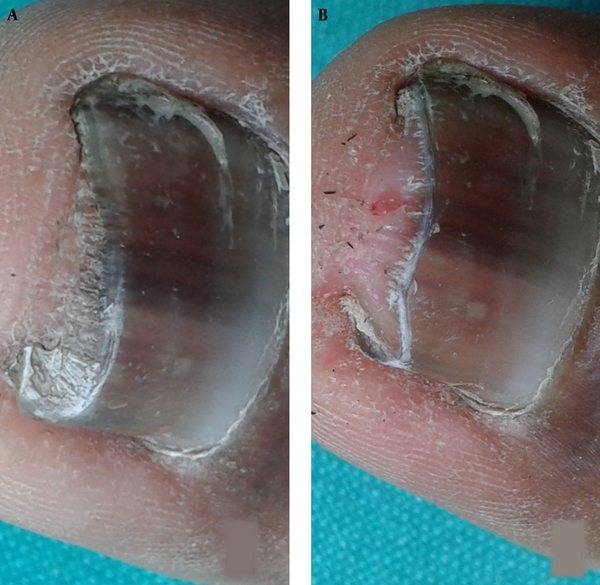Dear editor,
Ingrown toenail is a painful disorder which is due to the pressure and the penetration injury of the nail to its distal half of the gutter. This leads to inflammation, infection, and granuloma formation in the gutter (1). For treating this, various modalities of treatment have been described to reduce the injury of the nail to the gutter (2, 3). The conservative treatment of the ingrown nail is to alleviate the injury and maceration of the gutter in the early stage (grade 1 or 2) to avoid invasive procedures. Here, the author has advocated a simplified outpatient office procedure for treating this disease in the grade 1 stage by a combination of nail resection and chemical splinting of gutter, which makes the splinting of ingrown nail easy.
Under asepsis, the resection of the distal part of the ingrown nail is done with the help of a nail cutter (Figure 1A and B). The patient got relieved instantly from pain after the resection of the nail. The macerated gutter is debrided, cleaned with a blunt blade of a nail cutter, and the gutter was made aseptic with lotion povidone-iodine and medical spirit. Cyanoacrylate glue (strong adhesive, hygroscopic and anti-infective adhesive) has been primarily used for wounds and sutures since 1988. This glue is cheaper and readily available in the clinic. The glue is applied fortnightly to seal the gutter and to blunt the subsequent regrowing lateral nail and spicule. Then the patient has been followed up fortnightly for three months, and the touch-up was done during follow-up and whenever required as this glue got partially dislodged from the gutter at an interval of 2 to 3 weeks in initial phase of therapy as a result of epidermal cell shedding. The patient was advised not to trim the nail till it crossed the gutter. The regrown nail crossed the nail gutter and without causing any injury to the gutter in about 3 months (Figure 2A-F). During the follow-up, no temporary allergy was seen at the site. During the application of glue, it should be used with caution and wearing a face mask as it might cause problems for the respiratory system. Initially, the glue sealed the gutter and protected it from maceration, and made the gutter healthy. Later, the glue sealed the gutter along with the blunted the regrown lateral nail. The ingrown nail with glue cast got separated from its bed, not from its nail due to some toe movement after 2 to 3 days, which was unable to penetrate in its gutter. The glue being hygroscopic in nature makes the gutter dry, healthy, hard, and maceration-free. Moreover, it makes a strong chemical cast with the nail, which blunts the regrown nail. These two above properties of the glue prevent the pressure and penetration of ingrown toenail to its gutter. Thus, this novel combination of nail resection (as palliation) and chemical splinting of the nail and gutter (as prevention) protects the gutter from ingrown nail injury and maceration. This study was done successfully on three patients without any side effects.
Therefore, the chemical splinting of the nail gutter after the resection of the ingrown nail becomes an easy, fast, and less painful procedure as compared to the untrimmed ingrown nail for treating mild to the moderate stage (grade 1 and 2) of the disease. This simple technique can halt the progression of the mild stage (grade 1) of the ingrown nail into the moderate to the severe stage (grade 2 and 3) if it is treated well in the early stage. This is a preliminary report. To judge the effectiveness of chemical splinting with cyanoacrylate glue, it should be tried on a large number of patients with early-stage ingrown nails.

